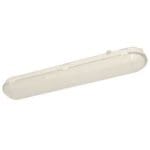
High Bay LED Lights Frequently Asked Questions – FAQs
What Kelvin should I select for my LED high bay lights?
Kelvin is the scientific measure of color. It is a measure of how much yellow or blue is contained in the spectrum of light emitted by the lamp. Higher Kelvin ratings do not mean brighter light, but rather whiter light. While the most frequently used Kelvin for high bay lights are 4000K and 5000K, high bay lights can be manufactured using 2200K, 3000K, 3500K, 4000K, 5000K, and 5700K, as well as in colors, 590nm, and No-UV.
- 5700K – 5700 Kelvin is used for applications including video and photography. A frequent option ordered with 5700K is 90+ CRI, high color rendering.
- 5000K – 5000 Kelvin LED high bay lights are the most common and are ideal for illuminating warehouses, and manufacturing facilities, commercial spaces requiring accurate lighting.
- 4000K – 4000 Kelvin LED high bay lights emit white that is warmer than 5000K. 4000K is frequently found in offices, warehouses and big box stores. This is partially due to the past prevalence of fluorescent and metal halide lights which were 4100K.
- 3500K – 3500 Kelvin is sometimes called neutral as it is neither white like higher Kelvins nor as yellow as warmer Kelvins. 3500 Kelvin is frequently found in upscale retail applications.
- 3000K – 3000 Kelvin is a warm color light that matches the light emitted by halogen light fixtures. 3000K is more white than the light emitted by an incandescent lamp such as the light emitted by a light bulb in a fine dining restaurant.
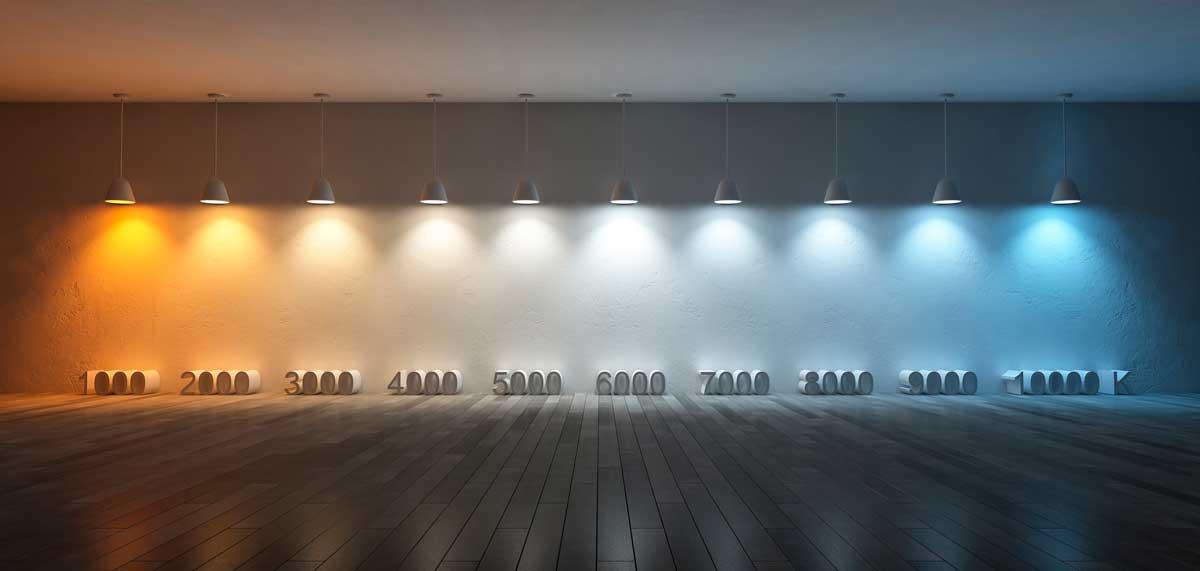
Are there different types of high bay LED lights?
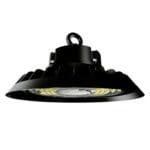
Round LED high bay lights frequently called UFO high bays
- Beam spread is typically very wide, allowing for broad light distribution
- Usually wet/damp location listed for use in tough conditions
- Mass produced and competitively priced
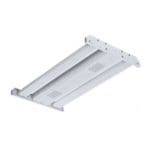
Linear LED High Bay Light Fixtures
- More diffused light with LEDs being distributed over a broad area
- Typically made with diffuser lenses to minimize any glare
- Available in various sizes, wattage, voltage and lumen output
- Excellent in locations where the ceiling is lower
- Diffuser lens minimizes glare
- Construction keeps out dirt, dust and/or water
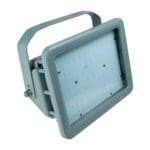
Hazardous Location/Explosion Proof High Bay Lights
- Hazardous Location / Explosion Proof rated
- Built for locations with flam¬mable gasses or vapors, flam¬mable liquids, combustible dust or ignitable fibers may exist
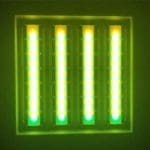
No UV – No Light Under 450nm LED High Bay Lights
- No UV – no light below 450 nm using LEDs, not filters
- Emits no UV so light emitted doesn’t impact the production process
- Many form factors available including for clean rooms
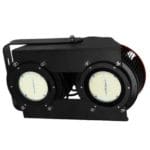
High Temperature LED High Bay Lights
- Purpose built for very high heat locations
- Optics may be available to high height too
- Designed for low to no maintenance in high heat locations

High Mounting Height LED High Bay Lights
- Made to be mounted at 30 to 50 feet above the work surface
- Optics designed to get the light emitted to where it is needed
- Linear and general lighting options available
Why do some high bay LED lights have 7 wires?
High bay LED light fixtures typically have 3, 5 or now ever 7 wires coming out of the fixture housing. In all cases two wires, black and white are for power while green is the ground. High bay lights with 5 wires are equipped for 0-10v dimming. High bay lights with 7 wires are built to accommodate 12v controls. In mt cases the wires are labeled, so you know which are for 0-10v dimming and which are for 12v controls. For more detail and a photo click here.
Why are some high bay LED lights wired with a long cord coming out of the high bay, while others do not have that cord?
Some high bay LED lights are designed with a cord that comes out of the fixture housing while other high bay LED lights do not have a cord coming out of the high bay light. The high bay lights with cords are typically those designed to be IP65, IP66 or IP67 rated. These fixtures are safety rated for damp to wet locations, or even submersible. Examples are APTA, HIIO, SYMA, and SYMO.
LED high bay lights that do not have a cord have an interior wire box where you will find the driver and wires. In this case it is up to the electrician to run the power line into the fixture and connect it to the wires on the driver in an area made just for that purpose. While the ingress into the fixture is not watertight, in this case it doesn’t matter as the LED high bay light is not watertight. Examples are OTAK, OTAM and OTOK.
What is the appropriate lumen rating for a high bay light?
Currently LED high bay lights with Kelvin between 3000K and 5700K emit between 120 luminaire lumens per watt (LPW) and 160 luminaire LPW. The lumens emitted vary due to the Kelvin of the LEDs, the efficiency of the LEDs, the milliamps of the driver and the optics. Watts times lumens per watt determines total lumens. What matters though is how many footcandles of light are distributed on the work surface where the light is needed. While the total lumens emitted is a factor in determining footcandles (fc), the mounting height of the high bay light and the optics used in the high bay light also are a factor in determining fc.
How many footcandles are required for my application?
The answer depends on the task and the application. These recommendations are based on Illuminating Engineering Society (IES) standards. IES is the recognized technical and educational authority on illumination.
The first list of recommendations is based on the task.
- Tasks with High Contrast and Large Size 30 fc
- Tasks with High Contrast and Small Size 50 fc
- Tasks with Low Contrast and Large Size 50 fc
- Tasks with Low Contrast and Small Size 100 fc
Below is a list based on applications where LED high bay lights might be used.
- Exhibit Space (Museum) 30 – 50 fc
- Gymnasium – Exercise 20 – 30 fc
- Gymnasium – Sports/Games 30 – 50 fc
- Laboratory (Classroom) 50 – 75 fc
- Laboratory (Professional) 75 – 120 fc
- Loading Dock 10 – 30 fc
- Lobby – Office/General 20 – 30 fc
- Mechanical / Electrical Room 20 – 50 fc
- Office – Open 30 – 50 fc
- Restroom / Toilet 10 – 30 fc
- Retail Sales 20 – 50 fc
- Storage Room – General 5 – 20 fc
- Workshop 30 – 75 fc
Is there a rough guideline for high bay lumens emitted and height?
This approximates how many lumens to employ based on mounting height.
- 10-15 feet – 10,000 to 15,000 lumens
- 15-20 feet – 16,000 to 20,000 lumens
- 25-35 feet – 30,000+ lumens
A photometric study is a computer simulated model of the light emitted and the results. It is the best way to determine how many lumens are required to supply sufficient light from your mounting height and the square footage of your facility.
Is there a guideline for spacing high bay lights?
This approximates the spacing based on mounting height. Basically, you should look at is as a gridded area with a high bay light in the center of each block of space with the area of the block based on the mounting height.
- 10’ to 15’ mounting height – 12’ to 15’ area/block
- 15’ to 20’ mounting height – 15’ to 20’ area/block
- 20’ to 30’ mounting height – 20’ to 25’ area/block
This is just a guideline, as it does not take into consideration the lumens emitted, the optics employed, or the footcandles required for the task to be performed. To determine the appropriate lighting layout for you facility get a photometric study.
What are IP ratings for LED high bay lights?
International Protection Rating, commonly referred to as an IP Rating, is defined in international standard IEC 60529. Instead of relying on vague marketing terms such as waterproof, purchasers can be assured by the classification of a specific standard. IP ratings classifies the degrees of protection provided against the intrusion of solid objects (including body parts like hands and fingers), dust, accidental contact, and water in electrical enclosures such as light fixtures.
Acquiring high bay lights with the minimum required IP ratings, ensures the fixture will meet the demands of the environment where it is installed. I your facility is wet or dirty, IP ratings matter. If you hate cleaning dead bugs out of your light fixtures, IP ratings matter.
Below is a list of common IP ratings for LED high bay lights.
- IP20 Protected from fingers and touch
No protection liquids. Susceptible to damage from contact with water - IP38 Protected from tools and wires greater than 2.5 millimeters
No protection liquids. Susceptible to damage from contact with water - IP40 Protected from tools and small wires greater than 1 millimeter
No protection liquids. Susceptible to damage from contact with water - IP41 Protected from tools and small wires greater than 1 millimeter
No protection liquids. Susceptible to damage from contact with water - IP42 Protected from tools and small wires greater than 1 millimeter
No protection liquids. Susceptible to damage from contact with water - IP65 No ingress of dust; complete protection against contact
No ingress of water projected by a nozzle (6.3mm) against fixture from any direction - IP66 No ingress of dust; complete protection against contact
No ingress by powerful water jets (12.5mm nozzle) against the fixture from any direction - IP67 No ingress of dust; complete protection against contact
No ingress of water in harmful quantity possible when the fixture is immersed in water under defined conditions of pressure and time (up to 1 m of submersion)
There are a few other standards such as Underwriters Laboratories (UL) standard UL1598. UL’s rating can also be trusted, but it is not as specific regarding solid and water ingress. UL1598 applies to luminaires for use in non-hazardous locations that are intended for installation on branch circuits of 600v nominal or less. If a LED high bay light is UL 1598 Wet Location rated, it is safe to use in a damp or wet location.
Contact an Access Fixtures Lighting Specialist to discuss which LED high bay fixture is best for your application.
How many LED high bay lights do I need?
There isn’t a simple answer to this question as the quantity of high bay fixtures required to illuminate and area for your application depends on multiple factors including your application. The list below includes some of the questions that need to be answered to determine the quantity of high bay LED fixtures required for your facility.
- What is the size of area to be illuminated?
- Obviously the bigger the area is, the more lights required to illuminate the area. The dimensions of the facility are required to determine the quantity of fixtures.
- How many lumens emitted by each fixture?
- If one high bay light emits 20,000 lumens and another high bay light emits 40,000 lumens you may think that you would need half as many fixtures if you selected the 40,000 lumen fixture. That may be correct, but what if the 40,000-lumen high bay is too intense relative to the mounting height, or provides too much light underneath the light and insufficient light levels nearby? Light has to be evenly distributed to be appropriate and effective.
- What is the mounting height of the fixtures?
- The mounting height partially determines the maximum lumens that can be emitted without the light becoming too intense or producing too much glare. For example. 15,000 lumens might work at a 15-foot mounting height, but 30,000 lumens would be too intense. Also, with increased mounting heigh you achieve superior light distribution.
- What is the Max/Min ratio required for the application?
- The max/min ratio is the maximum light in the area divided by the minimum light in the area. For most sports, the max/min required is less than 3.0. According to IESNA, a walkway for general use at night should be max/min of 10 or less, but if the guests using the walkway are residents of an assisted living facility, the max/min should be less than 5.0. You need to know how even the light needs to be for your application and that specification is in turn met by the spacing/distribution of the light fixtures.
- What is the application of the area?
- The function performed in the facility determines the footcandles (fc) of light required on the work surface. A large warehouse used for storage requires lower fc as compared with a facility where small electronics are being assembled. Tasks with high contrast and large size require 30 fc on the work surface, while tasks with low contrast and small size require 100fc.
An Access Fixtures Lighting Specialist can help you appropriately illuminate your facility. Call 800.468.9925 or click here to contact an Access Fixtures Lighting Specialist.
Should I retrofit old high bay lights or buy new LED high bay lights?
Old high bay light fixtures use Metal Halide (MH), Pulse Start Metal Halide (PSMH), Mercury Vapor (MV) or fluorescent tubes. The earlier can be converted to LED by bypassing the old ballast and connecting the power directly to the socket in the fixture. Once rewired, you can install an HID replacement LED light bulb that provides the lumens and light distribution and pattern similar to what the high bay previously emitted. It works, but the performance is not as good as that of purpose built LED high bay lights and the life span is typically less than purpose built LED lights. Also, as the fixture was not designed for LED lamps, the fixture may not be considered to pass UL for the application, and it may not be an accepted use by OSHA.
Fluorescent high bay lights depending on age use T12, T12HO, T8, T8HO, or T5HO fluorescent lamps. There are conversion lamps that use the old ballast and wiring, as well as self-ballasted LED lamps that use tombstones or lamp holders that are direct wired to the power source. This is a link to information on how to rewire a fluorescent fixture for LED conversion lamps. Read it before purchasing the conversion lamps. Fluorescent LED conversion lamps require more labor to install and come with lots of hassles. Again, as the fixture was not designed for LED lamps, the fixture may not be considered to pass UL for the application, and it may not be an accepted use by OSHA. Once installed, it may work for a while, but when the issues start again like flickering or whatever, you will rue the day that you didn’t purchase a purpose built LED high bay light fixture.
If you would like to discuss conversion options with an Access Fixtures lighting specialist call 800.468.9925
or click here.
How do I wire LED high bay lights?
LED high bay lights are typically installed by a licensed electrician. For commercial installations, a licensed electric is typically required by ordinance. If the installation requires the fixture to be hardwired, you should hire a licensed electrician. Also, the warranty may require installation by a licensed electrician.
Assuming that the fixture has 3 wires or you will not be using 0-10v dimming or controls, there are two primary ways to wire a LED high bay light are to put a plug on the end of the cord and plug it into an outlet located near the fixture, or to hardwire the fixture by connecting the cord to the power source in an electrical box that is again located near the fixture. Wiring the LED high bay light using a plug an outlet enables the fixture to be easily disconnected and take down for cleaning and or for service. If the fixture is not water-resistant or waterproof, there will most likely be a location inside the fixture for the power to be connected to the power source eliminating the need for a nearby electrical box.
If you are using 0-10v dimming or 12v controls, you will need 5 core conduit. With 0-10v dimming or 12v controls, two wires being the black and white are for power. Green is the ground. The two other wires in the conduit are used for the low voltage 0-10v diming or 12v controls. 0-10v dimming or 12v controls are virtually always hardwired.
If you would like to discuss conversion options with an Access Fixtures lighting specialist call 800.468.9925
or click here.
What are the advantages of using LEDs for high bay lighting?
For high bay lights, LED technology is now basically ubiquitous. It has replaced legacy lighting technologies including Metal Halide (MH), Pulse Start Metal Halide (PSMH), Mercury Vapor (MV), fluorescent and Induction. There are a host of reasons. The list below is by no means complete.
LED high bay lights…
- Use less energy
- Require low to no maintenance
- Have very slow lumen depreciation
- Generate far less heat
- Offer more options for Kelvin
- Feature superior color rendering
- Have LED optic the provide excellent light distribution
- Are less expensive on a per lumen basis
Get answers. Contact a lighting specialist at Access Fixtures. Call 800.468.9925 or click here.
How do you go from metal halide to LED?
In most instances metal halide high bay lights can be swapped out for LED high bay lights on a one for one basis. Using a one-for-one basis reduces the labor cost and maintains even light distribution assuming the light would be even if the old fixtures still worked. The one-for-one swap should consider all the factors that should be thought of when purchasing lighting such as the lumens emitted, hours of use, heat in the location, mounting height, optics, etc., but let’s keep it simple here.
The most common legacy high bay light is a high bay light with a 400w Metal Halide (MH) lamp. This fixture uses about 460 system watts of power including the lamp and ballast. As legacy lighting was expensive, many facilities were previously under illuminated, so selecting something with a little more light is a good decision and there will still be significant energy savings.
A 400w MH high bay emits 24,000 mean luminaire lumens. That means the light fixture emits and average of 24,000 lumens between the time the MH light bulb is new and when it burns out. To replace it one for one you would look for a LED high bay light that emits over 24,000 lumens as the LED fixture assuming L70 @ 50,000 hours will have lumen depreciation of 30% over 50,000 hours. The HIIO 200 or HIIO 240 are both examples of LED high bay lights that are one-for-one replacements.
What do you have for high bay lights now? Does your facility have any special requirements? Speak with an Access Fixtures Lighting Specialist to find your best choice for new LED high bay lights.
How long do LED high bay lights last?
The life of an LED high bay light depends on several factors with the 3 primary factors being the quality or effectiveness of the heat sinking, the driver, and the heat in the location that the LED high bay light will be deployed.
With legacy lighting technologies, lumen depreciation happens quite quickly. For example, a metal halide lamp might have 35% lumen depreciation at 40% of the average lamp life which is about 8,000 hours of use. In other words, while the fixture still uses a lot of electricity you get only 65% of the light.
Over the course of the life of a LED high bay light, the LEDs gradually emit less light too. LED high bay lights have a rating called L70. The fixture is considered to have reached the rated life at when it emits 30% less light than when new. How do the 3 primary factors affect life? Let’s look.
LED High Bay Light Life – L70 at how many hours?
LED high bay lights are rated with a minimum of L70 @ 50,000 hours. That means after 50,000 hours the LEDs will still emit 70% of the original light emitted. Assuming 12 hour use 5 days a week per year, the rated life is over 15 years. Some Access Fixtures’ LED high bay lights are rated EXTREME-LIFE. This means the fixture is rated L70 @ 100,000 hours or more. Many Access Fixtures’ LED high bay lights are rated L70 @ 200,000 hours and some are even L70 @ 300,000 hours. In cases where access to the fixtures is difficult or for some reason very expensive, L 70 # 300,000 hours can be a significant value add.
LED High Bay Light Life – The Driver Matters
The LEDs may be L70 @ 50,000 hours, but that doesn’t mean the driver will last. It is difficult to determine if the quality of one driver is better another. What can be determined is how the driver is housed in the fixture. Heat kills drivers. Most L70 @ 50,000 hour high bay lights are UFOs which have the drivers directly above the LED fixture and heat sink. The driver can be protected and consequently the life extended by housing the driver in a separate section of the high bay light. The cost can be significantly more, but if EXTREME-LIFE is a requirement, the additional cost can be worth it.
LED High Bay Light Life – High Heat Locations Kills LEDs and Drivers
A process such as making steel or heat processing generates extreme heat near the ceiling and that is where the LED high bay fixtures are located, and the heat can’t be reduced. LED high bays can be purpose built to withstand high heat. First the LEDs need to have superior heat sinking. Also, the life of the LEDs can be extended my running them at very low miiliamps (mA). This under drives the LEDs and extends the life. To deal with high heat the driver has to be protected too. This is done by placing the driver in a separate compartment or by placing the driver in a separate compartment that is located remotely. In other words the driver is located a distance away from the part of the fixture that emits light.
If you have a special requirements for your LED high bay fixtures contact an Access Fixtures Lighting Specialist.

